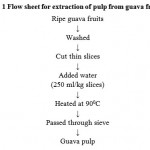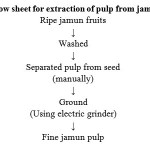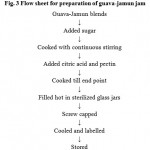Manuscript accepted on : 02 September 2016
Published online on: --
Plagiarism Check: Yes
Study of the Effect of Storage on Chemical Constituents of Guava-Jamun Jam
Rashmi Bhardwaj1, Rakesh Gehlot2 and Diwakar Mishra1
1Dairy Technology Section, SRS, ICAR-NDRI, Bangalore-560030.
2CFST, CCS Haryana Agricultural University, Hisar, Haryana.
Corresponding Author E-mail: bhardwaj.rashmi20@gmail.com
DOI : http://dx.doi.org/10.13005/bbra/2320
ABSTRACT: Jam is a fruit based spread commonly consumed with bread or chapati. In this study, jam was prepared from various blends of guava and jamun and was further analyzed for changes in their chemical constituents and overall acceptability at an interval of one month for three months storage. Storage studies showed an increase in total and reducing sugars, while a decrease was observed in ascorbic acid, anthocyanins and total phenols in all the blends during storage. Jam containing guava and jamun in ratio of 40:60 was most acceptable in its sensory acceptability score among all the blends.
KEYWORDS: Guava; jamun; blends; jam; chemical constituents; overall acceptability; storage
Download this article as:| Copy the following to cite this article: Bhardwaj R, Gehlot R, Mishra D. Study of the Effect of Storage on Chemical Constituents of Guava-Jamun Jam. Biotech Res Asia 2016;13(3). |
| Copy the following to cite this URL: Bhardwaj R, Gehlot R, Mishra D. Study of the Effect of Storage on Chemical Constituents of Guava-Jamun Jam. Biotech Res Asia 2016;13(3). Available from: https://www.biotech-asia.org/?p=16176 |
Introduction
Fruits and vegetable processing industry possesses a bright future in India. Value added processed foods are becoming popular among the consumers due to the changing socio-economic scenario of the country. The natural fruit products have high nutritional, medicinal and calorific values, which can further be improved by blending pulp or juice of two or more fruits having excellent flavour, delicious taste and high nutritive and therapeutic values.
Guava (Psidium guajava L.) belongs to family Myrtaceae which contains about 100 species of tropical shrubs and small trees. Guavas are mainly cultivated in tropical and sub-tropical countries. Guava fruits are rich in dietary fibre, vitamin A, vitamin C, folic acid and dietary minerals mainly potassium, copper and manganese. Guava contains both carotenoids and polyphenols like leucocyanidin, guaijaverin, gallocatechin, the major classes of antioxidant pigments giving them relatively high antioxidant value among plant foods. Guava is also found effective against cancer, bacterial infections, inflammation and pain.
Guava is a seasonal fruit and is highly perishable in nature. Short shelf life limits its selling. A wide variety of value added products can be prepared from this fruit including beverages, jam, jelly, cheese and toffee. Consumers, generally, have less preference for guava products inspite of its good flavour, delicious taste, and high nutritional and medicinal value.
The black plum or Indian blackberry, commonly known as Jamun (Syzygium cumini L.) is also an important member of family Myrtaceae. It is widely grown throughout India and other tropical and sub-tropical countries. Its fruits are oblong, ovoid and crimson black in colour at ripe stage. Jamun fruits are used in Ayurveda and Unani systems of medicine. Its fruits and leaves are used for curing stomach disorder, whereas seed powder and pure juice are used for curing diabetes. Seeds are rich in carbohydrates, proteins and calcium and can be used as a concentrate in animal feed. Fruits are stomachic and diuretic apart from having cooling and digestive properties. These are also used as herbal medicine from ancient age and are reported to be beneficial for diabetic persons. Jamun fruits show antioxidant property which is due to flavonoids and anthocyanins present in it.
The ripe fruits are highly perishable in nature and available only for a very short duration during June-July. Jamun fruits are generally consumed in fresh form. The surplus produce can be processed into value added products like jam, jelly, chutney, sauce, cheese and toffee. Jamun juice, being acidic and astringent in taste, has not been used much and is yet to pick up the impetus for being utilized extensively for processing.
 |
Figure 1: Flow sheet for extraction of pulp from guava fruits.
|
Table 1: Effect of storage on total sugars (%) of guava-jamun jam
| Guava:Jamun | 0 | 1 | 2 | 3 |
| 100:00 | 51.91 | 52.80 | 53.49 | 54.10 |
| 80:20 | 51.79 | 52.61 | 53.00 | 53.70 |
| 60:40 | 51.62 | 52.49 | 52.60 | 52.80 |
| 40:60 | 51.30 | 51.72 | 52.33 | 52.60 |
| 20:80 | 51.20 | 51.60 | 52.07 | 52.30 |
| 00:100 | 51.10 | 51.41 | 51.65 | 52.09 |
*C.D for storage is 0.07
Table 2: Effect of storage on reducing sugars (%) of guava-jamun jam
| Guava:Jamun | 0 | 1 | 2 | 3 |
| 100:00 | 31.47 | 32.17 | 33.53 | 34.67 |
| 80:20 | 31.80 | 32.52 | 33.90 | 34.73 |
| 60:40 | 32.70 | 33.19 | 34.20 | 35.70 |
| 40:60 | 33.32 | 33.90 | 34.91 | 35.94 |
| 20:80 | 34.41 | 35.22 | 35.51 | 36.37 |
| 00:100 | 34.92 | 35.51 | 36.74 | 37.19 |
*C.D for storage is 0.41
Blending of pulp/juice from two or more fruits improves the colour and appearance, flavour, aroma, taste, mouth feel including overall cost and nutrition for the preparation of the processed products. Therefore, blending of jamun pulp/juice with guava pulp can supplement their blended products with vitamins, minerals, bright colour, besides improving their taste, flavour and overall acceptability. Keeping the above facts in view, the present study was planned with the objectives to standardize appropriate combination of Guava-Jamun blends for preparation of jam and also to evaluate storage quality of blended products.
Table 3: Effect of storage on acidity (%) of guava-jamun jam
| Guava:Jamun | 0 | 1 | 2 | 3 |
| 100:00 | 0.88 | 0.84 | 0.79 | 0.75 |
| 80:20 | 0.93 | 0.91 | 0.84 | 0.81 |
| 60:40 | 1.02 | 0.98 | 0.95 | 0.9 |
| 40:60 | 1.10 | 1.05 | 1.00 | 0.95 |
| 20:80 | 1.23 | 1.19 | 1.14 | 1.09 |
| 00:100 | 1.29 | 1.24 | 1.19 | 1.15 |
*C.D for storage is 0.01
Materials and Methods
The present investigation was carried out in Fruits and Vegetables Processing Technology Laboratory of Centre of Food Science and Technology, CCS Haryana Agricultural University, Hisar during the year 2012-13. Uniformly ripe guava and jamun fruits were procured from local market of Hisar. Guava fruits were washed thoroughly and cut into thin slices with stainless steel knife. The slices were then heated after addition of 25 per cent water. After cooling, slices were crushed manually through stainless steel sieve and pulp was collected in a container.
 |
Figure 2: Flow sheet for extraction of pulp from jamun fruits.
|
Jamun fruits were also washed thoroughly with water and pulp was separated manually from stones, mixed with 25% water and blended in a mixer/blender to obtain fine pulp.
Table 4: Effect of storage on pH of guava-jamun jam
| Guava:Jamun | 0 | 1 | 2 | 3 |
| 100:00 | 3.24 | 3.27 | 3.32 | 3.49 |
| 80:20 | 3.23 | 3.29 | 3.34 | 3.41 |
| 60:40 | 3.19 | 3.24 | 3.27 | 3.32 |
| 40:60 | 3.12 | 3.21 | 3.27 | 3.28 |
| 20:80 | 3.12 | 3.18 | 3.23 | 3.27 |
| 00:100 | 3.06 | 3.13 | 3.17 | 3.18 |
*C.D for storage is 0.01
The guava and jamun pulp were blended in different ratio of 100:0, 80:20, 60:40, 40:60, 20:80 and 0:100, respectively. For preparing jam, one kg blended pulp was cooked after mixing 750 g sugar, 4 g citric acid and 5 g pectin. Prepared jam was filled hot in 150 g capacity sterilized glass jars, screw capped properly, cooled in air, labelled and stored at room temperature for three months.
 |
Figure 3: Flow sheet for preparation of guava-jamun jam.
|
Table 5: Effect of storage on ascorbic acid (mg/g) of guava-jamun jam
| Guava:Jamun | 0 | 1 | 2 | 3 |
| 100:00 | 28.61 | 26.60 | 24.92 | 21.33 |
| 80:20 | 25.15 | 21.72 | 18.27 | 16.56 |
| 60:40 | 19.91 | 17.32 | 14.74 | 12.17 |
| 40:60 | 15.51 | 13.90 | 11.31 | 8.73 |
| 20:80 | 11.33 | 8.72 | 6.15 | 3.57 |
| 00:100 | 6.95 | 5.35 | 3.50 | 2.07 |
*C.D for storage is 1.30
Table 6: Effect of storage on anthocyanins (mg/g) of guava-jamun jam
| Guava:Jamun | 0 | 1 | 2 | 3 |
| 100:00 | ND | ND | ND | ND |
| 80:20 | 15.51 | 13.50 | 10.55 | 7.73 |
| 60:40 | 36.67 | 34.19 | 32.61 | 30.22 |
| 40:60 | 49.70 | 48.05 | 45.61 | 42.5 |
| 20:80 | 59.91 | 57.19 | 54.04 | 52.31 |
| 00:100 | 80.34 | 79.61 | 77.90 | 73.93 |
*C.D for storage is 1.02
Guava-Jamun jam was analyzed for changes in chemical constituents and overall acceptability at monthly interval for three months. Total and reducing sugars were estimated by the method of Hulme and Narain (5). Acidity was analyzed by titration against 0.1N sodium hydroxide (Ranganna, 11), while pH of the product was recorded by pH meter (Model: CL 54 Digital Toshniwal Instruments Mfg. Pvt. Ltd., India). Ascorbic acid was analyzed by AOAC (1) method. Anthocyanins were extracted with ethanolic HCl and measured at 535 ηm wavelength, while total phenols were analyzed by the method of AOAC (1). The overall acceptability of guava-jamun jam was based on mean scores obtained for all the sensory characters. The characters with mean scores of 6 or above out of 9 were considered acceptable. The treatments were replicated thrice and the data were analyzed statistically using completely randomized design. The critical difference value at 5 per cent level was used for making comparison among different period of time during storage.
Table 7: Effect of storage on total phenols (mg GAE/g) of guava-jamun jam
| Guava:Jamun | 0 | 1 | 2 | 3 |
| 100:00 | 61.40 | 59.32 | 57.01 | 53.17 |
| 80:20 | 74.34 | 72.12 | 69.17 | 66.63 |
| 60:40 | 82.51 | 80.34 | 76.15 | 74.10 |
| 40:60 | 95.38 | 92.32 | 88.97 | 86.94 |
| 20:80 | 108.31 | 106.09 | 103.05 | 101.32 |
| 00:100 | 121.72 | 119.77 | 116.32 | 113.18 |
*C.D for storage is 0.89
Table 8: Effect of storage on overall acceptability of guava-jamun jam
| Guava:Jamun | 0 | 1 | 2 | 3 |
| 100:00 | 8.30 | 7.70 | 7.61 | 7.33 |
| 80:20 | 8.61 | 7.91 | 7.70 | 7.57 |
| 60:40 | 8.70 | 8.19 | 7.90 | 7.82 |
| 40:60 | 8.61 | 8.31 | 8.10 | 7.91 |
| 20:80 | 8.52 | 7.90 | 7.77 | 7.44 |
| 00:100 | 8.23 | 7.94 | 7.73 | 7.41 |
*C.D for storage is 0.0.30
Results and Discussion
A gradual and significant increase in total and reducing sugars was observed in guava-jamun jam with the advancement in storage period. This increase in sugars may be due to hydrolysis of polysachharides into their constituent sugars and inversion of sugars. Similar findings have been cited by Mishra et al. (10) in ready-to-eat aonla chutney and Khan et al. (8) in strawberry jam. There was significant increase in pH and significant decrease in acidity of guava-jamun jam during three months storage period. The increase in pH and decrease in acidity of blended products might be attributed to chemical degradation. The results are in conformity with those obtained by Kannan and Thirumaran (7) in jamun products and Domale et al. (3) in aonla toffee.
The ascorbic acid content of blended products decreased significantly in blended jam during storage. This may be due the fact that it is sensitive to light and oxygen, and gets readily oxidized. Similar reduction in ascorbic acid was recorded by Hussain and Shakir (6) in apricot and apple jam, and Bhuiyan (2) in fresh hog plum chutney. Anthocyanins decreased significantly in guava-jamun jam during three months of storage period. Anthocyanins are phenolic compounds which are highly volatile and are easily oxidized. These might also have decreased due to their condensation into brown pigments during storage. Similar results were reported by Kannan and Thirumaran (7) in jamun products and Kopjar et al. (9) in strawberry jam. Total phenols also decreased significantly in all the blended products during three months storage. The phenolic compounds are highly volatile and are easily oxidized to give brown products of high molecular weight. The decrease in total phenols during storage might also be due to their condensation into brown pigments (Fenemma, 4).
A non significant decrease in overall acceptability of guava-jamun jam was recorded during three months storage period, however, organoleptic score of all the blended products remained above the acceptable level even after three months of storage. This might be due to changes in chemical constituents or certain enzymatic and non-enzymatic changes in the products. The present findings are in accordance with those of Domale et al. (3) in aonla toffee and Verma and Chopra (12) in aonla-mango mixed fruit slab.
Conclusion
The study revealed that with increase in storage period, an increase in total and reducing sugars occurred, while a decrease was observed in ascorbic acid, anthocyanins and total phenols in all the blends. But all the blends remained acceptable till end of three months storage. Jam prepared by blending of guava and jamun in 40:60 was liked the most among all other blends and thus scored highest overall acceptability sensory score.
Acknowledgement
Centre of food science and technology, CCS Haryana Agricultural University, Hisar is acknowledged for providing infrastructure and facilities to successfully accomplish this project.
References
- O.A.C. 1990. Official Methods of Analysis. Association of Official Analytical Chemists, Washington D.C. 15th edition.
- Bhuiyan, M.H.R. 2012. Pickle and Chutney Development from Fresh Hog Plum (Spondias dulcis). Environ. Sci. Nat. Res. 5(2): 67-72.
- Domale, N.S., Kotecha, P.M. and Pawar, V.D. 2008. Studies on preparation of toffee from aonla pulp. Beverage & Food World 35(9): 39-40.
- Fenemma, O.R. 1976. Priniciples of Food Science. Part-I. Food Chemistry. Marcel Dekker Inc., New York and Basel. pp. 80-81.
- Hulme, A.C. and Narain, R. 1931. The ferricyanide method for determination of reducing sugars: A modification of Hagedom-Jensen-Hanes technique. Biochem J. 25: 1051-1061.
CrossRef - Hussain, I. and Shakir, I. 2010. Chemical and organoleptic characteristics of jam prepared from indigenous varieties of apricot and apple. World J. Dairy Food Sci. 5(1): 73-78.
- Kannan, S. and Thirumaran, A.S. 2004. Studies on storage life of jamun (Syzygium cuminii) fruit products. J. Food Sci. Technol. 41(2): 186-188.
- Khan, R.U., Afridi, S.R., Ilyas, M., Sohail, M. and Abid, H. 2012. Development of strawberry jam and its quality evaluation during storage. Pakistan J. Biochem. Mol. Biol. 45(1): 23-25.
- Kopjar, M., Pilizota, V., Tiban, N.N., Babic, D.S.J., Ackar, D. and Sajdl, M. 2009. Strawberry Jams: Influence of Different Pectins on Colour and Textural Properties. J. Food Sci. 27(1): 20–28.
CrossRef - Mishra, P., Verma, M., Mishra, P., Mishra, S. and Rai, G.K. 2011. Studies on development of ready to eat amla chutney and its preservation using class one preservatives. American J. Food Technol. 6(3): 244-252.
CrossRef - Ranganna, S. 2003. Handbook of Analysis and Quality Control for Fruit and Vegetable Products. Tata McGraw Hills Publishing Co. Ltd., New Delhi.
- Verma, G. and Chopra, C.S. 2010. Preparation and preservation of aonla-mango mixed fruit slab. Beverage & Food World 37(1): 60-61.

This work is licensed under a Creative Commons Attribution 4.0 International License.





